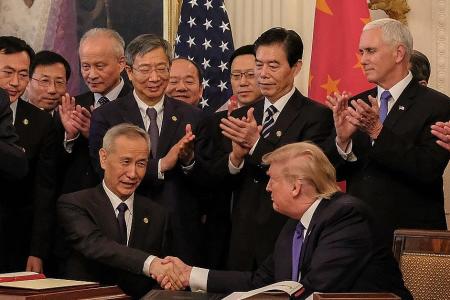Trade deal won’t do much to heal US-China rifts: Experts
Observer says initial deal can be seen as emergency treatment but doesn't address fundamental issues
WASHINGTON/BEIJING: From Huawei to the South China Sea, deep political rifts between Beijing and Washington are set to persist, despite a trade relations breakthrough, as the US pushes back against an increasingly powerful and assertive China.
Relations between the two have deteriorated sharply since US President Donald Trump imposed punitive trade tariffs in 2018, igniting a trade war.
"The broader, darkening picture is not going to be brightened much by this deal," Dr Bates Gill, an expert on Chinese security policy at Macquarie University in Sydney, said of the initial trade deal signed on Wednesday.
This backdrop spans China's militarisation of the South China Sea; rising tensions over Taiwan, which Beijing claims as its own; US criticism over human rights in Hong Kong and Xinjiang and a backlash against telecom gear provider Huawei.
According to the phase one deal, China will boost purchases of US goods and services by US$200 billion (S$270 billion) over two years in exchange for the rolling back of some tariffs.
Commitments include US$54 billion in additional energy purchases, US$78 billion in additional manufacturing purchases, US$32 billion more in farm products and US$38 billion in services, showed documents released by the White House and China's Finance Ministry.
While the deal defuses an 18-month row that hit global growth, experts say it is unlikely to provide much balm for broader frictions rooted in US fears over an economically and technologically powerful China with a modernising military.
"We can see phase one as an emergency treatment to lower the temperature, but it has not addressed the fundamental problems," said Professor Wang Heng of the University of New South Wales in Sydney who studies the China-US economic relationship.
Washington is increasingly alarmed about the security implications of Chinese technology, and it has tightened rules to keep better tabs on acquisition of key technology by China, setting in motion changes to the global supply chain.
"The Chinese leadership are not naive about this," said Dr Gill. "They are already making moves to be more autonomous and thinking about a future... in an environment of hostility."
The Trump administration put Chinese telecom equipment giant Huawei Technologies on a trade blacklist on national security concerns in May, banning it from buying supplies from American companies without US government approval.
It has also taken measures to crimp exports of artificial intelligence software.
The two countries are also at odds over Taiwan, which counts the US as its biggest weapons supplier but which China sees as one of its provinces.
The phase one deal cancelled planned US tariffs on Chinese-made mobile phones, toys and laptop computers, and halved the tariff rate to 7.5 per cent on about US$120 billion worth of Chinese goods, including flat-panel TVs, Bluetooth headphones and footwear.
It will leave in place 25 per cent tariffs on a US$250 billion array of Chinese industrial goods and components used by US manufacturers, and China's retaliatory tariffs on over US$100 billion in US goods. - REUTERS
Get The New Paper on your phone with the free TNP app. Download from the Apple App Store or Google Play Store now


